2011 TOYOTA URBAN CRUISER change wheel
[x] Cancel search: change wheelPage 132 of 532
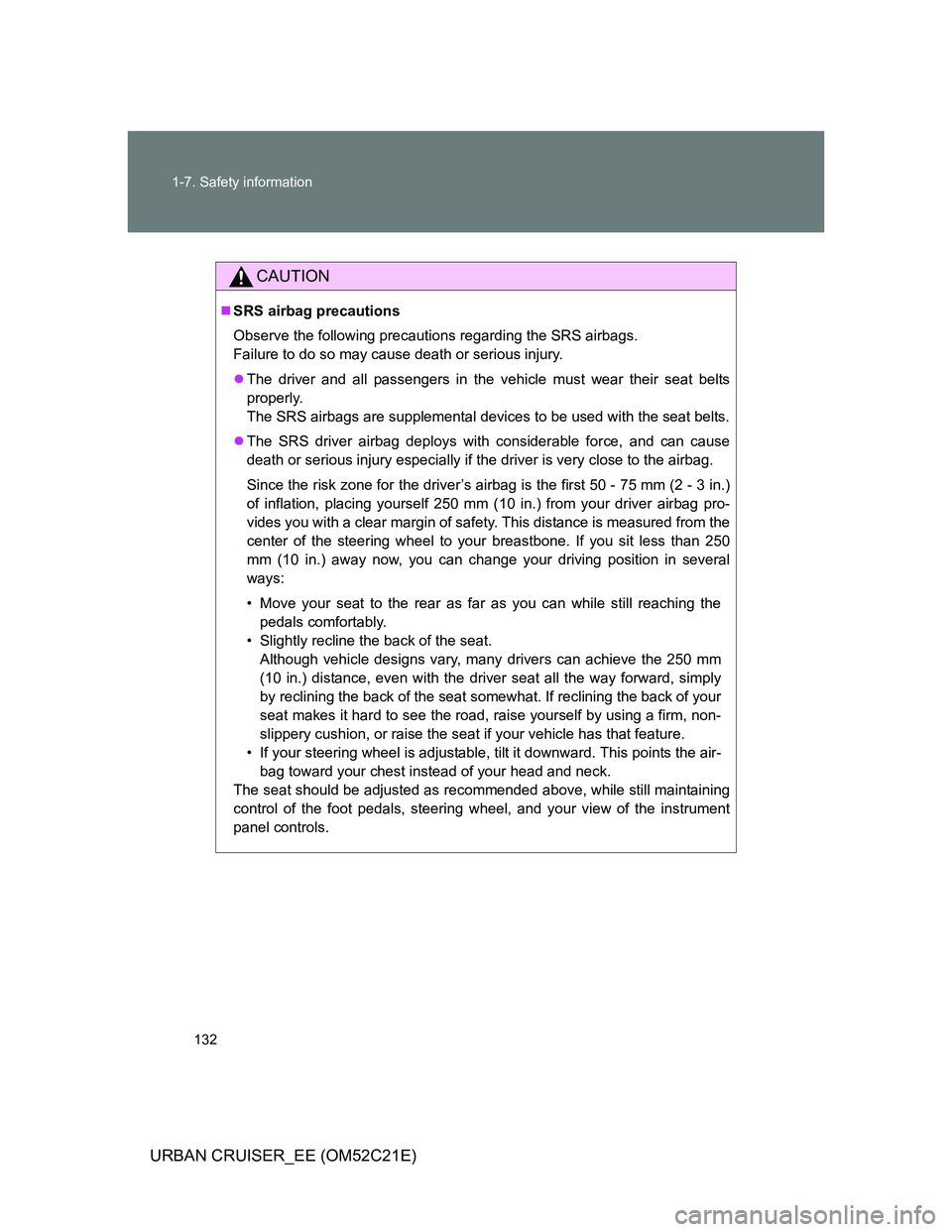
132 1-7. Safety information
URBAN CRUISER_EE (OM52C21E)
CAUTION
SRS airbag precautions
Observe the following precautions regarding the SRS airbags.
Failure to do so may cause death or serious injury.
The driver and all passengers in the vehicle must wear their seat belts
properly.
The SRS airbags are supplemental devices to be used with the seat belts.
The SRS driver airbag deploys with considerable force, and can cause
death or serious injury especially if the driver is very close to the airbag.
Since the risk zone for the driver’s airbag is the first 50 - 75 mm (2 - 3 in.)
of inflation, placing yourself 250 mm (10 in.) from your driver airbag pro-
vides you with a clear margin of safety. This distance is measured from the
center of the steering wheel to your breastbone. If you sit less than 250
mm (10 in.) away now, you can change your driving position in several
ways:
• Move your seat to the rear as far as you can while still reaching the
pedals comfortably.
• Slightly recline the back of the seat.
Although vehicle designs vary, many drivers can achieve the 250 mm
(10 in.) distance, even with the driver seat all the way forward, simply
by reclining the back of the seat somewhat. If reclining the back of your
seat makes it hard to see the road, raise yourself by using a firm, non-
slippery cushion, or raise the seat if your vehicle has that feature.
• If your steering wheel is adjustable, tilt it downward. This points the air-
bag toward your chest instead of your head and neck.
The seat should be adjusted as recommended above, while still maintaining
control of the foot pedals, steering wheel, and your view of the instrument
panel controls.
Page 174 of 532
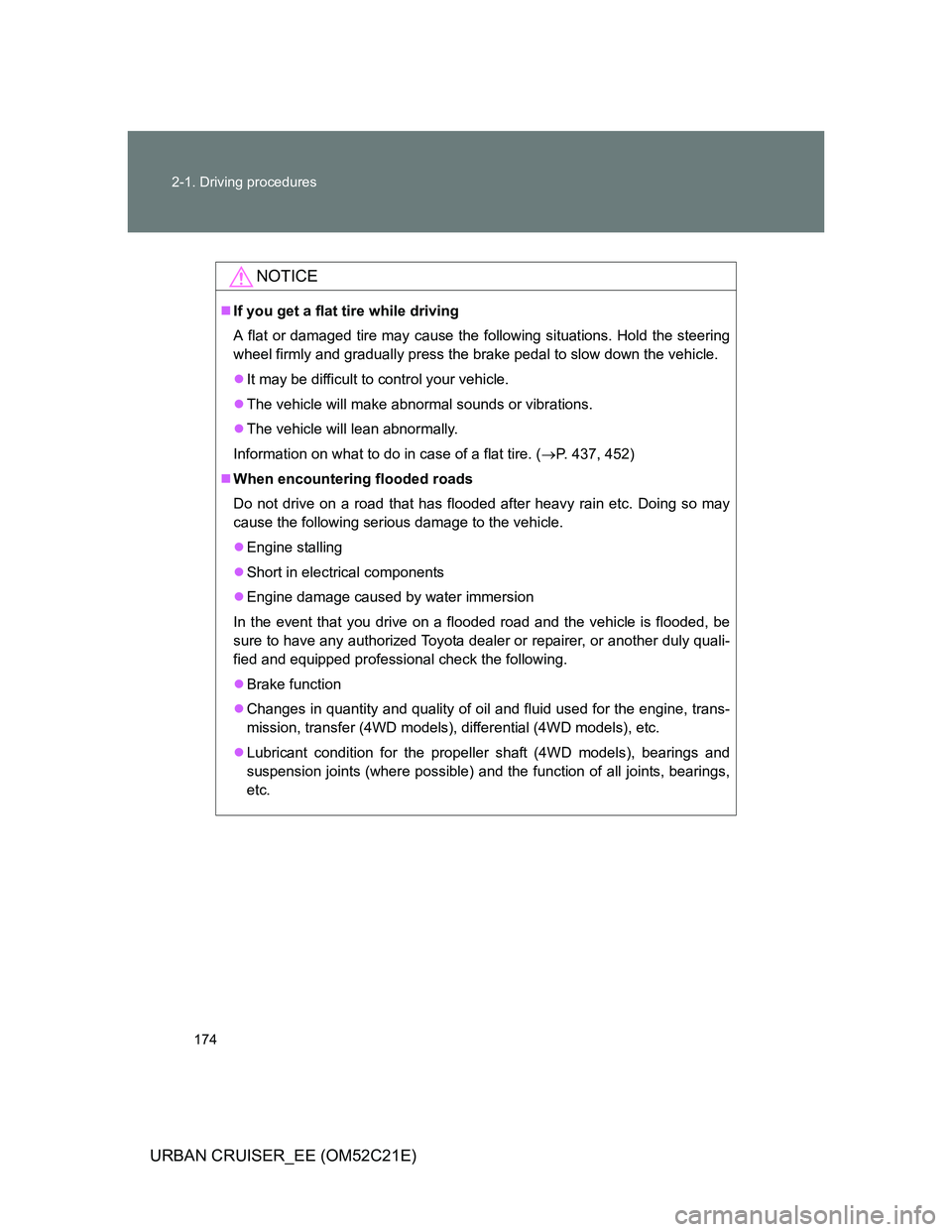
174 2-1. Driving procedures
URBAN CRUISER_EE (OM52C21E)
NOTICE
If you get a flat tire while driving
A flat or damaged tire may cause the following situations. Hold the steering
wheel firmly and gradually press the brake pedal to slow down the vehicle.
It may be difficult to control your vehicle.
The vehicle will make abnormal sounds or vibrations.
The vehicle will lean abnormally.
Information on what to do in case of a flat tire. (P. 437, 452)
When encountering flooded roads
Do not drive on a road that has flooded after heavy rain etc. Doing so may
cause the following serious damage to the vehicle.
Engine stalling
Short in electrical components
Engine damage caused by water immersion
In the event that you drive on a flooded road and the vehicle is flooded, be
sure to have any authorized Toyota dealer or repairer, or another duly quali-
fied and equipped professional check the following.
Brake function
Changes in quantity and quality of oil and fluid used for the engine, trans-
mission, transfer (4WD models), differential (4WD models), etc.
Lubricant condition for the propeller shaft (4WD models), bearings and
suspension joints (where possible) and the function of all joints, bearings,
etc.
Page 238 of 532
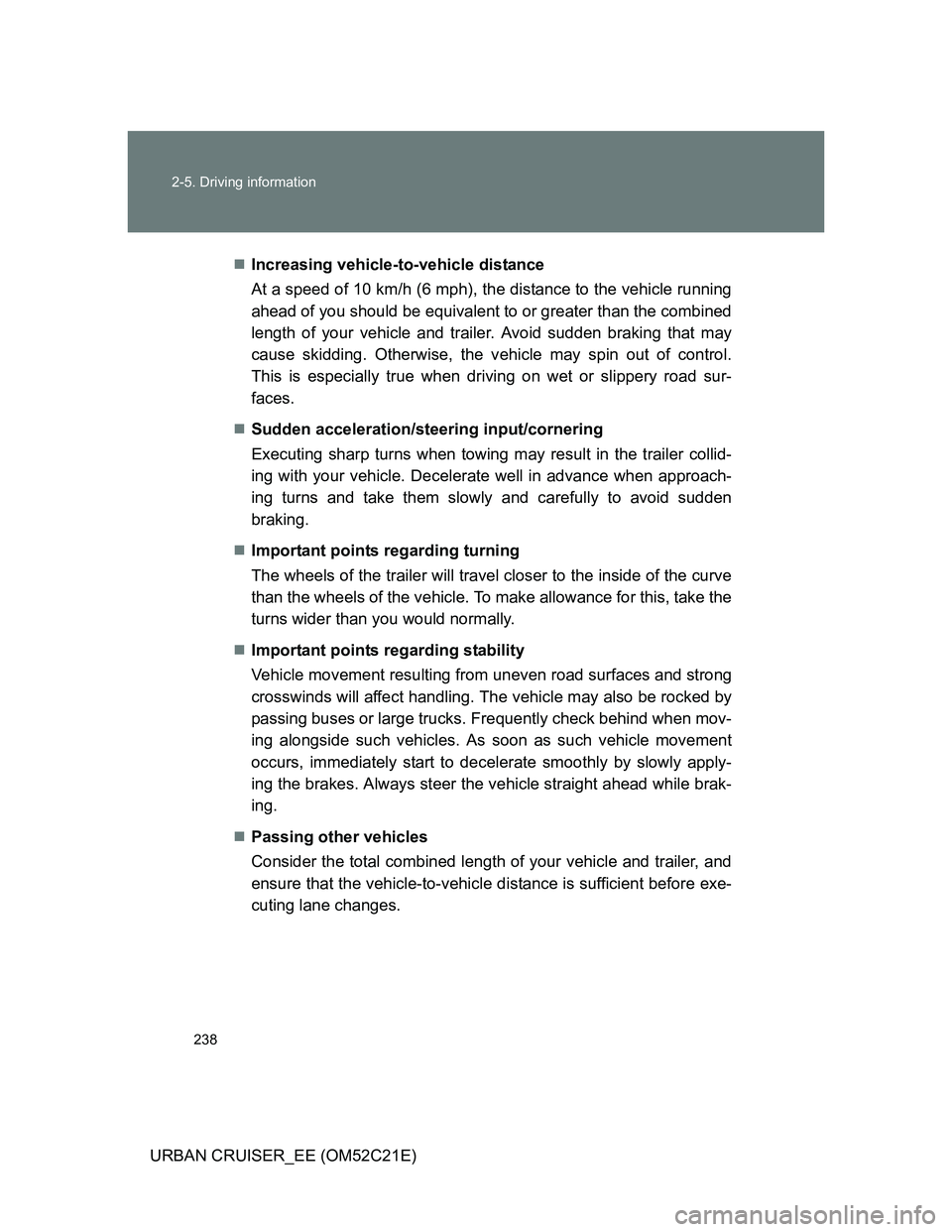
238 2-5. Driving information
URBAN CRUISER_EE (OM52C21E)Increasing vehicle-to-vehicle distance
At a speed of 10 km/h (6 mph), the distance to the vehicle running
ahead of you should be equivalent to or greater than the combined
length of your vehicle and trailer. Avoid sudden braking that may
cause skidding. Otherwise, the vehicle may spin out of control.
This is especially true when driving on wet or slippery road sur-
faces.
Sudden acceleration/steering input/cornering
Executing sharp turns when towing may result in the trailer collid-
ing with your vehicle. Decelerate well in advance when approach-
ing turns and take them slowly and carefully to avoid sudden
braking.
Important points regarding turning
The wheels of the trailer will travel closer to the inside of the curve
than the wheels of the vehicle. To make allowance for this, take the
turns wider than you would normally.
Important points regarding stability
Vehicle movement resulting from uneven road surfaces and strong
crosswinds will affect handling. The vehicle may also be rocked by
passing buses or large trucks. Frequently check behind when mov-
ing alongside such vehicles. As soon as such vehicle movement
occurs, immediately start to decelerate smoothly by slowly apply-
ing the brakes. Always steer the vehicle straight ahead while brak-
ing.
Passing other vehicles
Consider the total combined length of your vehicle and trailer, and
ensure that the vehicle-to-vehicle distance is sufficient before exe-
cuting lane changes.
Page 289 of 532
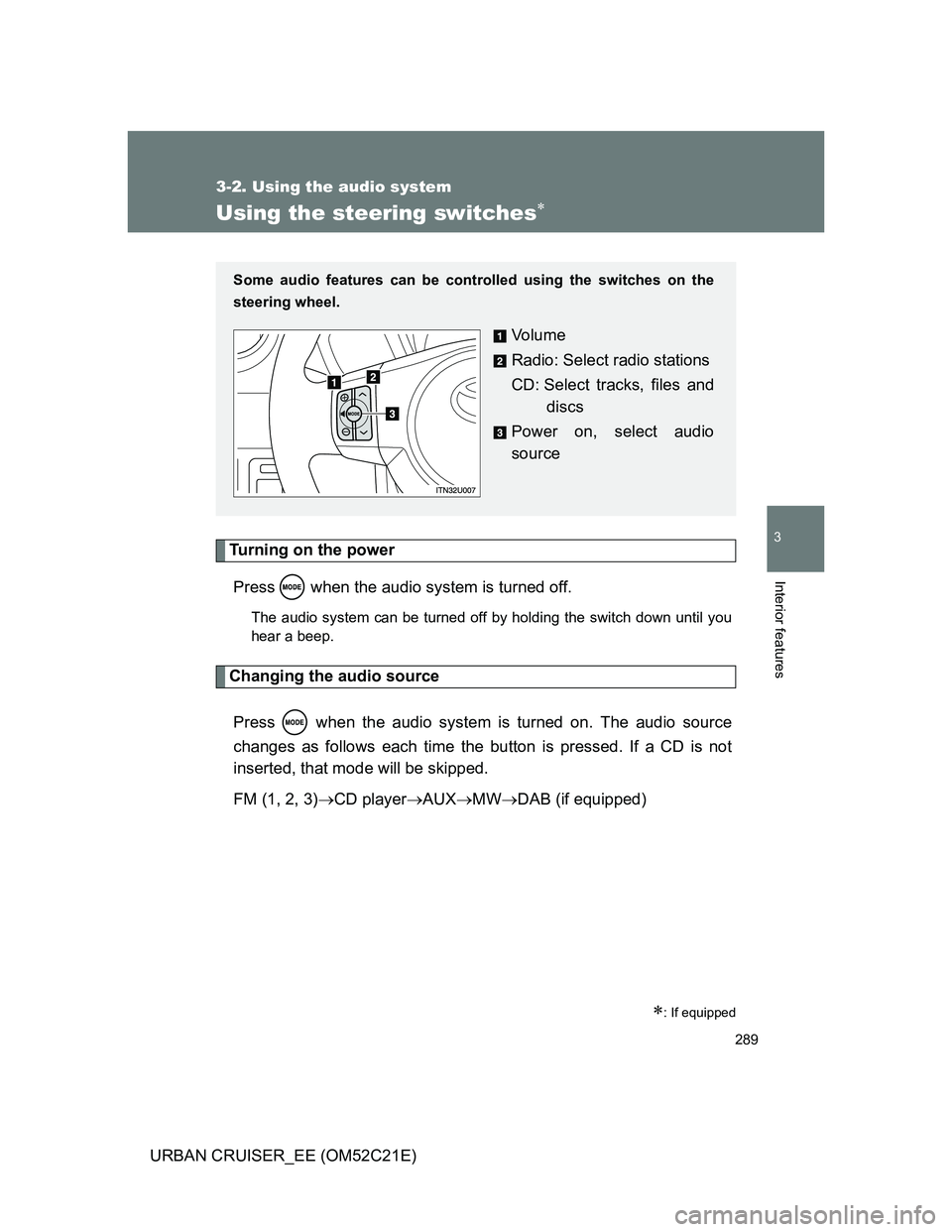
289
3-2. Using the audio system
3
Interior features
URBAN CRUISER_EE (OM52C21E)
Using the steering switches
Turning on the power
Press when the audio system is turned off.
The audio system can be turned off by holding the switch down until you
hear a beep.
Changing the audio source
Press when the audio system is turned on. The audio source
changes as follows each time the button is pressed. If a CD is not
inserted, that mode will be skipped.
FM (1, 2, 3)CD playerAUXMWDAB (if equipped)
: If equipped
Some audio features can be controlled using the switches on the
steering wheel.
Vo l u m e
Radio: Select radio stations
CD: Select tracks, files and
discs
Power on, select audio
source
Page 290 of 532
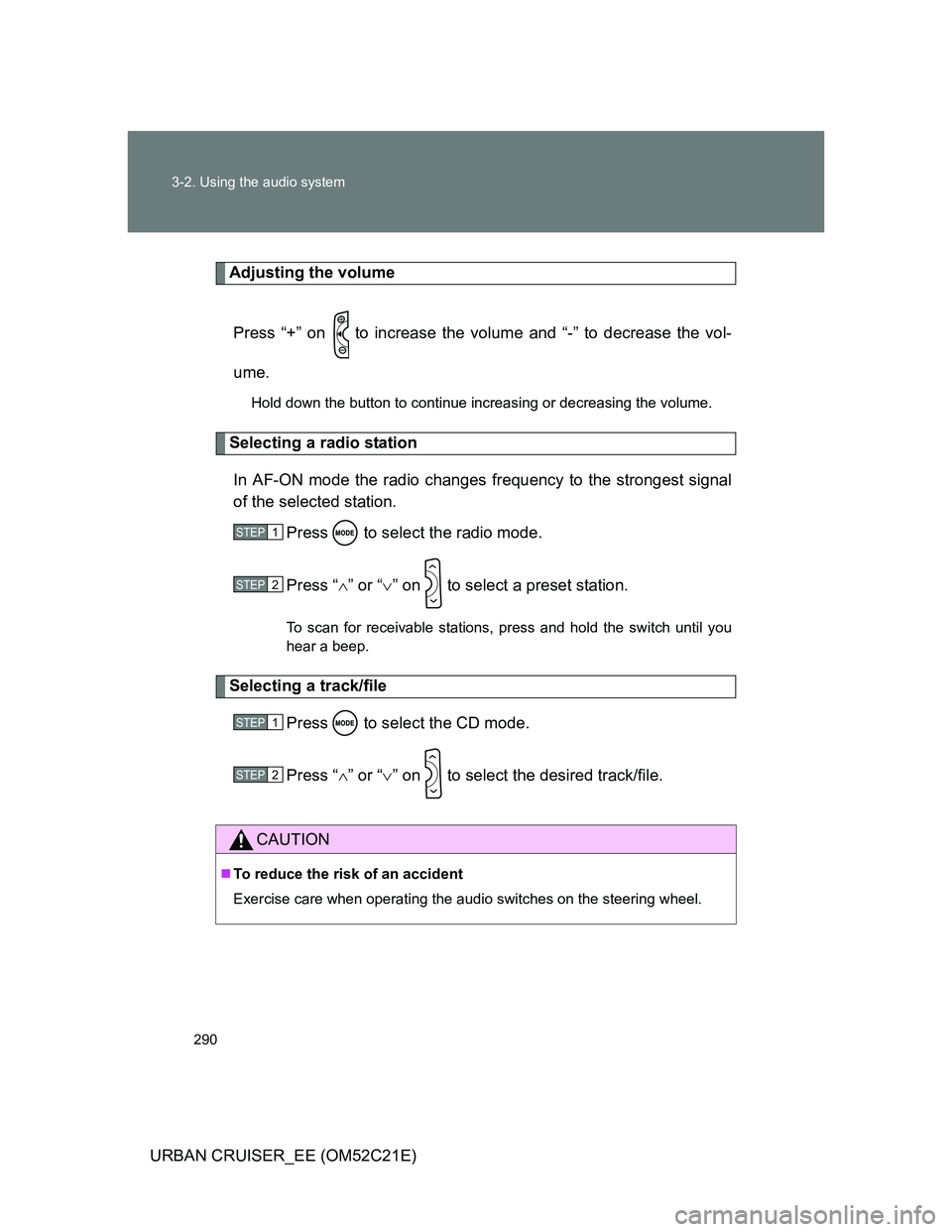
290 3-2. Using the audio system
URBAN CRUISER_EE (OM52C21E)
Adjusting the volume
Press “+” on to increase the volume and “-” to decrease the vol-
ume.
Hold down the button to continue increasing or decreasing the volume.
Selecting a radio station
In AF-ON mode the radio changes frequency to the strongest signal
of the selected station.
Press to select the radio mode.
Press “” or “” on to select a preset station.
To scan for receivable stations, press and hold the switch until you
hear a beep.
Selecting a track/file
Press to select the CD mode.
Press “” or “” on to select the desired track/file.
CAUTION
To reduce the risk of an accident
Exercise care when operating the audio switches on the steering wheel.
STEP1
STEP2
STEP1
STEP2
Page 526 of 532
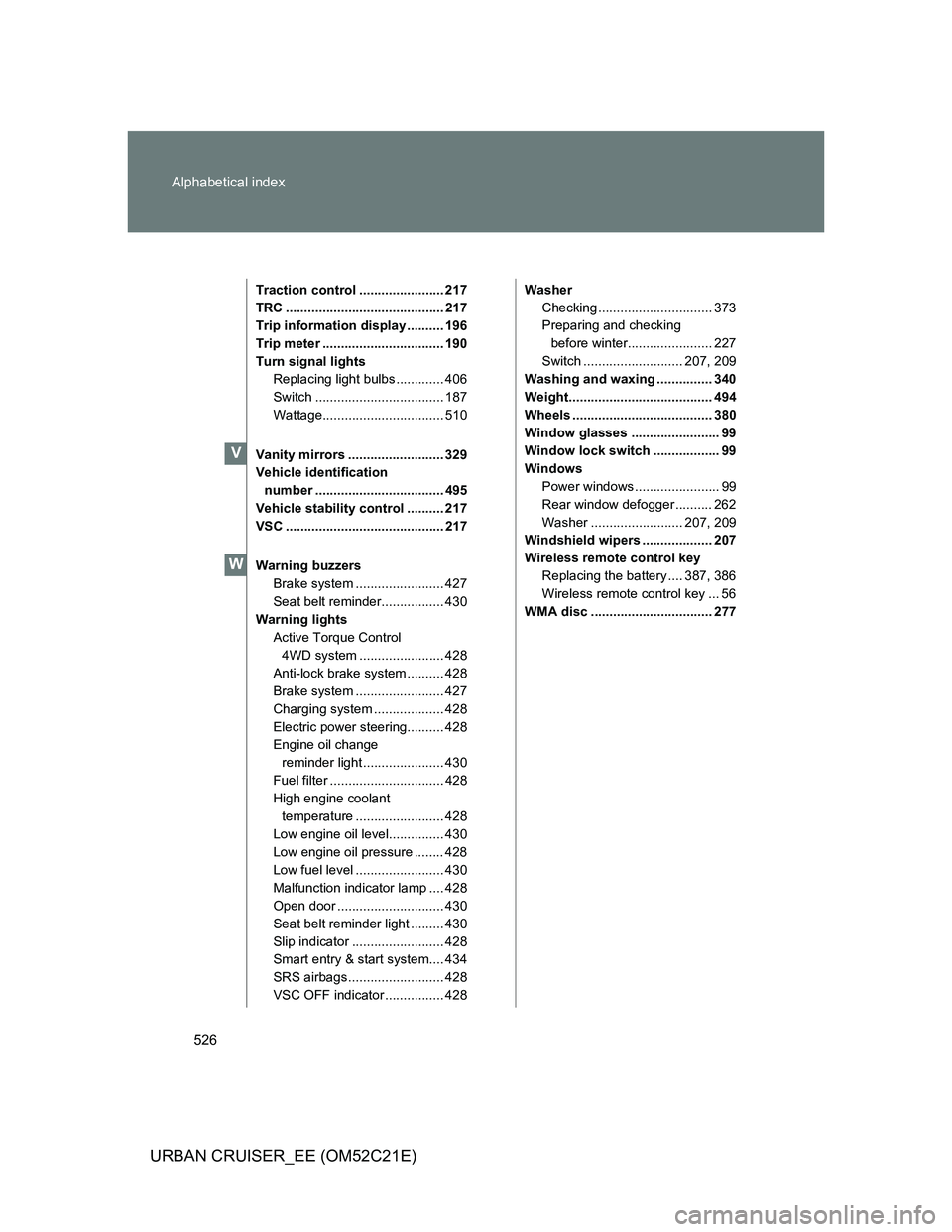
526 Alphabetical index
URBAN CRUISER_EE (OM52C21E)
Traction control ....................... 217
TRC ........................................... 217
Trip information display .......... 196
Trip meter ................................. 190
Turn signal lights
Replacing light bulbs ............. 406
Switch ................................... 187
Wattage................................. 510
Vanity mirrors .......................... 329
Vehicle identification
number ................................... 495
Vehicle stability control .......... 217
VSC ........................................... 217
Warning buzzers
Brake system ........................ 427
Seat belt reminder................. 430
Warning lights
Active Torque Control
4WD system ....................... 428
Anti-lock brake system .......... 428
Brake system ........................ 427
Charging system ................... 428
Electric power steering.......... 428
Engine oil change
reminder light ...................... 430
Fuel filter ............................... 428
High engine coolant
temperature ........................ 428
Low engine oil level............... 430
Low engine oil pressure ........ 428
Low fuel level ........................ 430
Malfunction indicator lamp .... 428
Open door ............................. 430
Seat belt reminder light ......... 430
Slip indicator ......................... 428
Smart entry & start system.... 434
SRS airbags .......................... 428
VSC OFF indicator ................ 428Washer
Checking ............................... 373
Preparing and checking
before winter....................... 227
Switch ........................... 207, 209
Washing and waxing ............... 340
Weight....................................... 494
Wheels ...................................... 380
Window glasses ........................ 99
Window lock switch .................. 99
Windows
Power windows ....................... 99
Rear window defogger .......... 262
Washer ......................... 207, 209
Windshield wipers ................... 207
Wireless remote control key
Replacing the battery .... 387, 386
Wireless remote control key ... 56
WMA disc ................................. 277
V
W